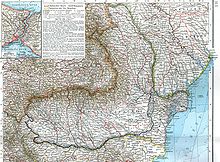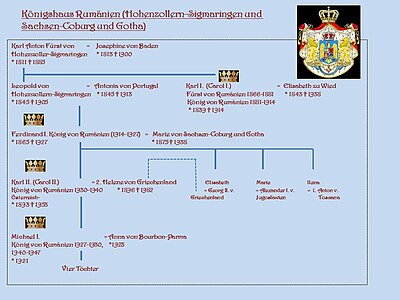Charles I (Romania)

Karl Eitel Friedrich Zephyrinus Ludwig von Hohenzollern-Sigmaringen (* 20th April 1839 in Sigmaringen , † September 27 . Jul / 10. October 1914 greg. On Peles Castle in Sinaia ) was from 1866 as I. Carol Prince and since 1881 King of Romania .
Life
Karl was a son of Prince Karl Anton zu Hohenzollern-Sigmaringen . He married Princess Elisabeth zu Wied (1843-1916) on November 15, 1869 in Neuwied am Rhein.
The state founder of the Principality of Romania, Alexandru Ioan Cuza , was unable to implement the reforms necessary for the country. He was therefore forced to abdicate in 1866 . A provisional government decided initially to appoint the brother of the Belgian King Leopold II , Philip of Flanders , as prince. But since this waived, Karl Eitel Friedrich von Hohenzollern-Sigmaringen was in February 1866 on the recommendation of Napoléon III. and elected prince after a referendum on April 20, 1866. On May 22, 1866, he entered Bucharest as Prince Carol I to the cheers of the people .
After Romania achieved independence from the Ottoman Empire in the Peace of San Stefano in 1878 , Charles was proclaimed King of Romania on March 26, 1881. He succeeded in giving the young state foreign and internal stability in the decades that followed. The reforms he promoted included state finances, an army based on the Prussian model , an expansion of the school system and the creation of railway lines. However, the peasant uprising in Romania in 1907 shook the country and drew attention to the untenability of the unjust distribution of land (large estates). Karl was just as unable to solve this problem as the largely oligarchic-undemocratic rule of the Romanian upper class at the time.
In terms of foreign policy, the king - including all of Hohenzoller - leaned against Germany and Austria-Hungary . However, at the beginning of the First World War in August 1914 , he was unable to maintain a secret military alliance with these powers (joining the Triple Alliance in 1883 ) due to the predominantly entente-friendly attitude of the political elite, which was the last few weeks of the aged ruler (who felt he had broken his word). gloomy.
Before that, after being neutral in the First Balkan War in 1912/13 , Romania had participated in the Second Balkan War for fear of Bulgaria becoming too powerful, achieving simple military successes and the incorporation of southern Dobruja into Romania (in the Bucharest Peace Treaty ).
Carol and Elisabeth's only child was their daughter Maria, who died in 1874 at the age of three. When King Carol died on October 10, 1914, his nephew Ferdinand I succeeded him. Carol I was buried in the Cathedral of Curtea de Argeș .
Honors
In the following decades, numerous Romanian cities erected monuments in honor of Charles I. Streets and squares were also named after him, such as the Bulevardul Carol I. There are monuments in Bucharest (Charles I on horseback; in front of the university library) and in Sinaia . The Carol I Mosque in Constana bears his name. In addition, the Romanian passenger ship Regele Carol I was named after him in 1898 .
See also
- Tribe list of the Hohenzollern
- Parcul Carol (Carol Park ) or Parcul Libertății (1900–1906, architect Eduard Redont ) named after him
literature
- Krista Zach: Karl I. (Carol I.) . In: Mathias Bernath, Felix von Schroeder (Ed.), Gerda Bartl (Red.): Biographical Lexicon for the History of Southeast Europe . Volume 2. Oldenbourg, Munich 1976, ISBN 3-486-49241-1 , pp. 367-369.
- Andreas Hillgruber : Karl I, Prince of Hohenzollern-Sigmaringen. In: New German Biography (NDB). Volume 11, Duncker & Humblot, Berlin 1977, ISBN 3-428-00192-3 , p. 260 f. ( Digitized version ).
- Edda Binder-Iijima: The institutionalization of the Romanian monarchy under Carol I. 1866–1881. (= Southeast European Works , Volume 118). Oldenbourg Verlag, Munich 2003, ISBN 3-486-56819-1 .
- Michael Kroner : The Hohenzollern as kings of Romania. Pictures of the lives of four monarchs 1866–2004 , Johannis-Reeg-Verlag, Heilbronn 2004, ISBN 978-3-937320-30-4 .
- Edda Binder-Iijima (Ed.): The Hohenzollern in Romania 1866-1947. A monarchical system of rule in a European context , Böhlau, Cologne 2010 (Studia Transsylvanica, Volume 41), ISBN 978-3-412-20540-9 .
- Sorin Cristescu: The letters of King Charles I of Romania to his family. Editura Paideia, Bucharest 2013, Volume 1: ISBN 978-973-596-868-7 , Volume 2: ISBN 978-973-596-869-4 , Volume 3: ISBN 978-973-596-870-0 .
- Silvia Irina Zimmermann : The first royal couple from Romania Carol I and Elisabeta. Aspects of monarchical legitimation in the mirror of cultural-political symbolic actions , Ibidem-Verlag, Stuttgart 2015 (series of the research center Carmen Sylva, Fürstlich-Wiedisches Archiv, Volume 3), ISBN 978-3-8382-0755-1 .
- Silvia Irina Zimmermann, Hans-Jürgen Krüger, Edda Binder-Iijima, Ralf Czapla (eds.): "In tender love your Elisabeth" - "Always your faithful Carl" Letters from Queen Elisabeth to King Carol I from the Romanian State Archives: Part 1 : 1869-1890, Part 2: 1891-1913. ibidem-Verlag, Stuttgart 2018, ISBN 978-3-8382-1221-0 , p. 950.
Web links
- Biography , Historia (Romanian)
- Newspaper article about Karl I in the 20th century press kit of the ZBW - Leibniz Information Center for Economics .
Individual evidence
- ^ Postcard Bucharest in 1918 with the Bulevard Karl I.
- ↑ Man in the snow in front of Carol-I. Monument in Bucharest in the German Digital Library ; Postcard around 1900 with a monument to Charles I in Bucharest
- ↑ Reference to a Karl I monument in Transylvania ( Memento of the original from March 12, 2014 in the Internet Archive ) Info: The archive link was inserted automatically and has not yet been checked. Please check the original and archive link according to the instructions and then remove this notice.
- ↑ Carol-I-. Mosque in Constana
| predecessor | Office | successor |
|---|---|---|
| Alexandru Ioan Cuza |
Prince of Romania 1866–1881 |
- |
| - |
King of Romania 1881–1914 |
Ferdinand I. |
| personal data | |
|---|---|
| SURNAME | Charles I. |
| ALTERNATIVE NAMES | Karl Eitel Friedrich Zephyrinus Ludwig von Hohenzollern-Sigmaringen; Carol I. |
| BRIEF DESCRIPTION | Prince and King of Romania |
| DATE OF BIRTH | April 20, 1839 |
| PLACE OF BIRTH | Sigmaringen |
| DATE OF DEATH | October 10, 1914 |
| Place of death | Peles Castle , Sinaia |


